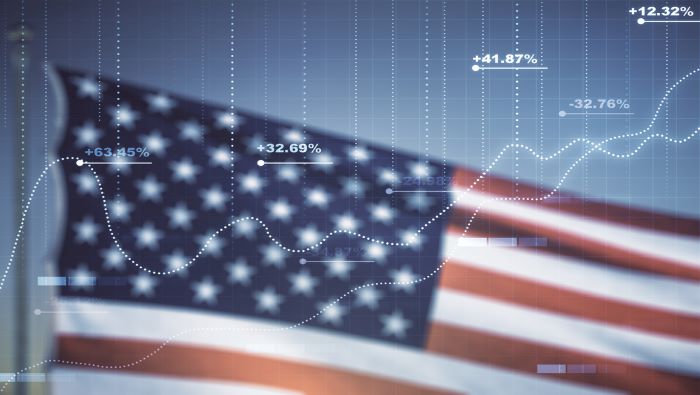One of the worst economic slumps in history is the Great Depression. Many valuable insights from it can be used today. This article outlines the complete structure and story of The Great Depression from its origins to the eventual upturn in economic activity.
What was The Great Depression?
The Great Depression was a fierce economic global depression starting in the United States and lasting roughly ten years. The phenomenon was characterized by declining GDP figures, deflation and high unemployment rates which sent systemic ripples throughout the world.
What caused the Great Depression?
1929 Stock Market Crash: Black Tuesday
The Wall Street crash of 1929 was largely believed to be the catalyst to the devastating Great Depression. It is widely believed that the market crash was as a result of an unprecedented stock market boom (speculative bubble) by overconfident investors in the then current economic climate.
During this period there were investors purchasing stocks on margin – paying a fraction of the price of the share and effectively borrowing the remaining balance. This allowed more money to be allocated to the stock market which drove prices exponentially higher. Coupled with manic buying, increased borrowing (loans) from banks and a confident economic outlook, the bubble grew.
Certain looming signs were apparent such as a declining agricultural sector. Prices for farm goods collapsed, when consumers couldn’t keep up with a surging supply of food. The collapse of food prices sent farmland prices plummeting. A similar pattern took place in other markets such as the automotive industry where technological advancements drove supply that outpaced demand. Many consumers stopped purchasing new cars, which left companies with standing stock.
Black Thursday (October 24, 1929) marked the start of the market correction with companies announcing disappointing earnings. The change in market outlook sparked the more popular Black Tuesday (October 29, 1929) decline which resulted in the ‘stock market crash’ we know today.
Great Depression Unemployment Rate
Often referred to as the first indicator that reveals the seriousness of the economic decline during the Great Depression is unemployment. With the U.S. at roughly full employment pre-depression, the chart below highlights the prominent rise in unemployment after the stock market crash in 1929. Unemployment reached highs of 25% which was abetted by the lack production output due to low demand (more detail covered below). This added to local economic woes and further supported the downturn.
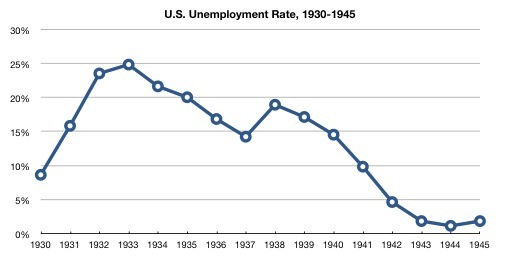
U.S. Investment Purchases
Poor GDP figures followed the Wall Street crash as business went bankrupt and the economy slowed. The major contributing factor to the decline in GDP in the initial period of The Great Depression is gross investment (see table below). Gross investment as we know it today includes household spending on homes, the purchase of equipment by businesses and construction. These sectors of the economy were unable to sustain prior spending after the market crash which led to the steady decline in GDP figures in the years that ensued.
| YEAR | GDP | CONSUMPTION | GROSS INVESTMENT | GOVERNMENT PURCHASES | EXPORTS | IMPORTS |
|---|---|---|---|---|---|---|
| 1929 | 790.9 | 593.9 | 92.4 | 105.4 | 35.6 | 46.3 |
| 1930 | 719.7 | 562.1 | 59.8 | 116.2 | 29.4 | 40.3 |
| 1931 | 674.0 | 544.9 | 37.6 | 121.2 | 24.4 | 35.2 |
| 1932 | 584.3 | 496.1 | 9.9 | 117.1 | 19.1 | 29.2 |
| 1933 | 577.3 | 484.4 | 16.4 | 112.8 | 19.2 | 30.4 |
| 1934 | 641.1 | 519.0 | 31.5 | 127.3 | 21.4 | 31.1 |
| 1935 | 698.4 | 550.9 | 58.0 | 131.3 | 22.6 | 40.7 |
Source: Bureau of Economic Analysis (BEA) – U.S. Department of Commerce
Deflation and Real Interest Rates
A reduction in money supply at the time of the stock market crash and a few years beyond led to falling GDP and deflation (see chart below). The effect of deflation on the real interest rate (difference between nominal interest rate and inflation) is the important aspect to consider.
U.S. Inflation Rates
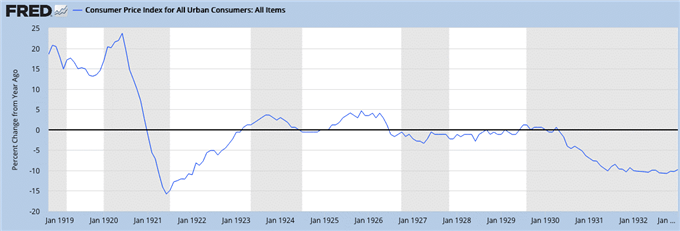
Source: FRED, federal reserve economic data
During the 1930s the real interest rate was notably increased relative to nominal rates by negative inflation. The U.S. reduced interest rates (see chart below) during this period but was overtaken by the rate of deflation as it was much higher than the rate at which interest rates were falling. This mismatch between deflation and interest rates can be viewed as a major cause of the Great Depression and for good reason.
U.S. Interest Rates

Source: FRED, federal reserve economic data
Gold Standard Abandonment: Contagion Effects
The gold standard is one major reason why the Great Depression spread to other countries. The gold standard is a system whereby a country’s local currency value is directly linked to gold. The major countries of the world then coordinated their interest rate policies around this gold standard. In the 1920s many countries abandoned the gold standard due to high levels of debt as a result of the war – to increase money supply.

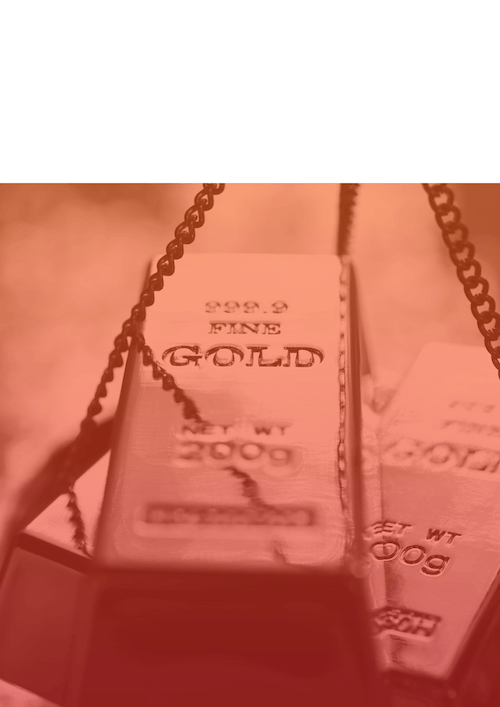

After the stock market crash both the U.S. and Great Britain abandoned the gold standard and continued to increase money supply. This flooded the market with fiat currency which brought a welcome relief for consumers. Many believe the gold standard caused the Great Depression but it was in fact the rejection of the gold standard that lead to the larger systemic effect. A comparison between the 19th century (largely under the influence of gold) and 20th century (fiat currency), there is a clear distinction between the flourishing economic environment in the 19th century relative to the higher frequency of economic issues in the 20th century.

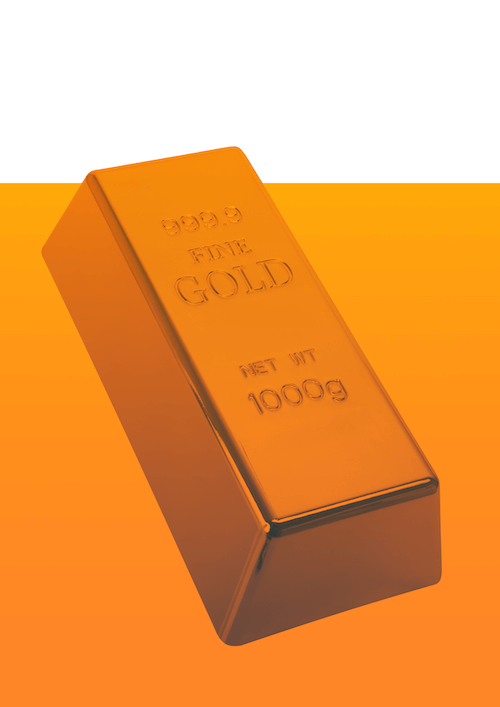

The gold standard was an anchor for markets and business at the time which contained guidelines and rules to adhere to. In my opinion, without the gold standard banks and business had more autonomy which essentially subsidized to the Great Depression.
How was the Great Depression Resolved
There are differing views on how the U.S. managed to climb out of the recession but three shared arguments continue to remain at the forefront of debate.
President Herbert Hoover
It is common to view the contribution of President Hoover as detrimental since the stock market crash of 1929 occurred under his watch. He alsosigned into effect the Smoot-Hawley Tariff Act-- essentially starting a trade war between the U.S. and Europe. However, there were several actions implemented by President Hoover that laid the foundation for President Franklin D. Roosevelt’s ‘New Deal’ policies enacted in the 1930s. Some of these measures included:
- Increase in agricultural subsidies.
- Hoover Dam funding.
- Glass-Steagall Act of 1932 – restricted actions of commercial banks.
President Franklin D. Roosevelt: The New Deal
The New Deal refers to a set of policies that greatly extended the federal government’s influence and function in the economy to address the Great Depression. There were two parts to the New Deal colloquially known as:
The First New Deal – This was the first action taken by the newly elected President in the midst of severe economic affliction. Initial focus was on unemployment, industry, the stock market and banking. Some of the laws include but are not restricted to:
- Securities and Exchange Commission (SEC)
- The Civilian Conservation Corps (CCC)
- The Federal Deposit Insurance Corporation (FDIC)
- The Federal Emergency Relief Act (FERA)
- The National Recovery Act (NRA)
- The Agricultural Adjustment Act (AAA)
The Second New Deal – This subsequent chapter of the New Deal attempted to give more emphasis to the labor market as well as longevity of the financial system and security for U.S. citizens. A few noteworthy pieces of legislation during the Second New Deal comprise:
- The Social Security Act.
- The Works Progress Administration (WPA).
- Fair Labor Standards Act.
- The Wagner Labor Relations Act.
The overall essence of the New Deal took into account increased spending in order to stimulate the economy. This being said, the Supreme Court prevented numerous New Deal proposals from taking effect, which put a hamper on President Roosevelt’s strategy.
End of World War II
The end of World War II marked the end of The Great Depression for many academics and scholars as pre-WWII data may have been somewhat distorted. For example, unemployment and GDP figures greatly improved during the war but did not echo in standard of living which remained poor. Unemployment figures looked promising purely due to millions of Americans joining the army. GDP improved thanks to an increase in production of military equipment. The increase in spending diverted funds from the private sector toward government production (military).
Once the war ended, millions of soldiers returned into the economy while government spending dropped. Many expected a restored recession but the economy flourished with lesser government spending as creativity prospered.
Contact and follow Warren on Twitter: @WVenketas


